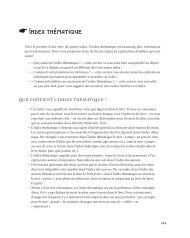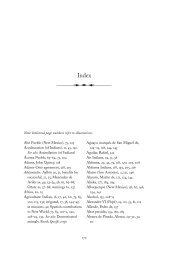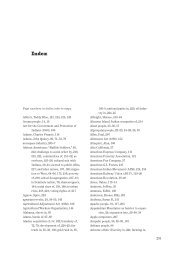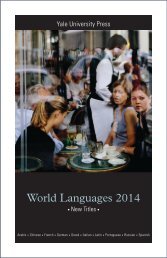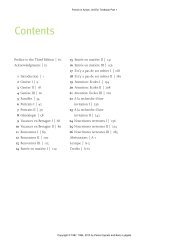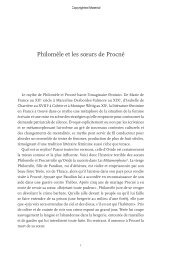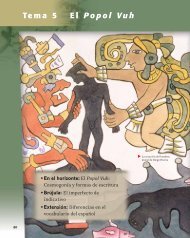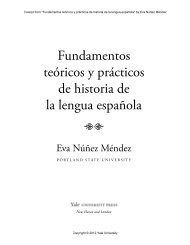Numbers in italics indicate figures. Abarbanel, in group portrait, 142 ...
Numbers in italics indicate figures. Abarbanel, in group portrait, 142 ...
Numbers in italics indicate figures. Abarbanel, in group portrait, 142 ...
You also want an ePaper? Increase the reach of your titles
YUMPU automatically turns print PDFs into web optimized ePapers that Google loves.
Index<br />
<strong>Numbers</strong> <strong>in</strong> <strong>italics</strong> <strong>in</strong>dicate <strong>figures</strong>.<br />
<strong>Abarbanel</strong>, <strong>in</strong> <strong>group</strong> <strong>portrait</strong>, <strong>142</strong>, 143<br />
Abbiate, L., 278<br />
Aduev, N. A., 262<br />
aero, 158, 195<br />
AERO: Articles and Projects (Khidekel and<br />
Chashnik), 215<br />
agitprop, 34, 63, 261–64<br />
Ahola-Valjo, Aleksanteri, 238–40<br />
Aizman, D. Y., 14<br />
Akhron, I., 265<br />
Alekseevskaya, N<strong>in</strong>a Arkadievna, 301<br />
All-Accessible Travel<strong>in</strong>g Theater, 251<br />
All-Russia Conference of Art Students and<br />
Teachers, 119, 140, 141–43, 148–53<br />
Alma, Peter, 218<br />
Altman, N. I., 39, 70, 226<br />
Amsky, I., 301<br />
Anarkhiia (Anarchy), Malevich publish<strong>in</strong>g <strong>in</strong>,<br />
124<br />
Anderson, Maria Karlovna Vasilieva-, 281<br />
Annenkov, Yu. P., 39<br />
An-sky, S. A., 3, 11, 14, 244, 245<br />
Antoshenko-Olenev, Valent<strong>in</strong>, 46<br />
Antsev, M. V., 268<br />
architectonics of responsibility, 305–6<br />
architectons (arkhitektons),64,153,164,172,<br />
312<br />
Argo (A. M. Goldenberg), 262<br />
Arkhangelsky, V. M., 286<br />
Arkhipenko, work of, selected for Vitebsk<br />
museum, 226<br />
Ark<strong>in</strong>, D. A., 148<br />
Aronson, G. Ya., 285, 297<br />
Art of Marc Chagall, The (Efros and Tugendkhold),<br />
45<br />
Arvatov, Boris, 204<br />
Ash Wednesday (Kleberg), 315<br />
Auer, L. S., 279<br />
avant-garde art, hoped-for relation of, to<br />
workers, 84<br />
Aver<strong>in</strong>tsev, S. S., 307<br />
Averka, Stefan, 6<br />
Azarkh-Granovskaya, A. V., 265<br />
Azarkh-Granovsky, A. M., 232<br />
Bai, E. S., 275, 278<br />
Bait<strong>in</strong>, Iosif A., 23, 38, 51, 52, 90,110,180;<strong>in</strong><br />
<strong>group</strong> <strong>portrait</strong>, <strong>142</strong>, 143; sculpture of, 50<br />
381
Bakale<strong>in</strong>ikov, V. R., 274<br />
Bakht<strong>in</strong>, Mikhail M., 6, 84, 259, 274, 279,<br />
288–89, 290, 291, 292; ‘‘Art and Responsibility,’’<br />
304–5; authorship of books attributed<br />
to other authors, 307; creation of<br />
the ‘‘first philosophy,’’ 305–6; dislike for<br />
Vitebsk, 306–7; first lecture of, at Vitebsk<br />
Pedagogical Library, 303–4; <strong>in</strong>difference<br />
of, 306; <strong>in</strong>fluences on thought of, 292–<br />
93; Medved’na bul’vare (The Bear on the<br />
Boulevard), 297; meet<strong>in</strong>g Chagall, 310;<br />
move to Nevel, 303; philosophical sem<strong>in</strong>ar<br />
at Vitebsk Institute of People’s Education<br />
(Ino), 309; preference for spoken word<br />
over writ<strong>in</strong>g, 306; Problems <strong>in</strong> Dostoevsky’s<br />
Art, 304; relationship with Malevich, 310–<br />
15; relationship with Pumpiansky, 297–99;<br />
relationship with Volosh<strong>in</strong>ov, 300–301; as<br />
symphonic person, 308; Vitebsk years,<br />
303–15<br />
Bakht<strong>in</strong>, Nikolai, 298, 310<br />
Bakht<strong>in</strong> circle, 288, 308; emergence of Dostoevsky<br />
theme <strong>in</strong>, 309–10<br />
Bakht<strong>in</strong> studies, accursed question of, 307–9<br />
Bakst, L. S., 20<br />
ballet, 280–81<br />
Balmont, Konstant<strong>in</strong>, 301<br />
Bauhaus, 137, 190<br />
B. Borokhov Club (Vitebsk), 69<br />
Bedny, Demian, 62<br />
Beekman, Chris, 218–20<br />
Be<strong>in</strong>arovich, T. T., 224<br />
Bell<strong>in</strong>g, Erast (Erikh) Evstafievich, 276–77,<br />
280, 300<br />
Bell<strong>in</strong>g, Sandra (Aleksandra Aleksandrovna),<br />
272, 276–77<br />
Belostotskaya, Fanya, 90, 131, <strong>142</strong>, 143<br />
Bely, Andrei, 301<br />
Berberova, N<strong>in</strong>a, 297<br />
Bernard, Joseph, 170<br />
Bernste<strong>in</strong>, Osip, 52, 90, 102; <strong>in</strong>volved with<br />
Unovis educational activities, 113; as Unovis<br />
office manager, 109<br />
Bertels, B. A., 261<br />
Besk<strong>in</strong>, Isaak R., 49, 50, 52, 90, 234, 238, 239;<br />
called to study <strong>in</strong> Moscow, 232; <strong>in</strong> <strong>group</strong><br />
<strong>portrait</strong>, <strong>142</strong>, 143<br />
382 Index<br />
Besk<strong>in</strong>, L., 240<br />
Bessmertny, A. L., 268, 274, 278<br />
Bialynitsky-Birulia, V., 269<br />
Black Square, 111–12, 123, 127; emblem for<br />
Suprematist form, 77, 143; as face of new<br />
art, 97<br />
Blok, Aleksandr, 269, 280, 287, 301<br />
Blue Blouse Theaters, 264<br />
Bocharov, S. G., 307<br />
Bogrov, G. I., 14<br />
Boguslavskaya, Ksenia (Ksana) L., 27, 32,<br />
33–34, 35–37<br />
book design and production: Constructivist<br />
technique, 76–77; Lissitzky’s <strong>in</strong>terest <strong>in</strong>,<br />
64–65<br />
Borisov, Alexander, 107<br />
Braude, S. O., 275, 279<br />
Brazer, Abram Markovich, 23, 25, 70, 226,<br />
239, 246, 265; Head of a Jewish Boy, 247;<br />
Portrait of D. A. Yakerson, 247; Portrait<br />
of Yu. M. Pen, 246; work of, selected for<br />
Vitebsk museum, 226, 227<br />
Brik, Lili, 38<br />
Brik, Osip M., 148, 204<br />
Bryusov, Valery, 301<br />
Buber, Mart<strong>in</strong>, 308–9<br />
Bun<strong>in</strong>, I. A., 3<br />
Burliuk, David, 32–33; work of, selected for<br />
Vitebsk museum, 226<br />
Burliuk, Vladimir, 32–33<br />
butcher shop signboard, 41<br />
Chaadaeva, A. P., 262<br />
Chagall, Bella, 266<br />
Chagall, Marc, 18, 32, 42, 47, 53, 90; Above<br />
Vitebsk, 146; accompany<strong>in</strong>g Pen for ple<strong>in</strong><br />
air draw<strong>in</strong>g, 17; Arts Commissar of October<br />
Revolution, 22; Blue House, The, 17; chairman<br />
of Vitebsk Board of Art and Artistic<br />
Production, 34; comments on Ermolaeva,<br />
40; concerned with plastic embodiment<br />
of artistic ideas, 58–59; creator of Vitebsk<br />
People’s Art School, 27; Cubist Landscape,<br />
28; cycle of etch<strong>in</strong>gs based on Gogol’s Dead<br />
Souls, 6; decorat<strong>in</strong>g Vitebsk, 22–26; desire<br />
of, to establish art museum <strong>in</strong> Vitebsk, 225–<br />
26; director of People’s Art School and<br />
head of Narkompros f<strong>in</strong>e arts program,<br />
39–40; Documents, 21–22; Documents of<br />
Vitebsk, 13; Fire <strong>in</strong> Vitebsk, The, 5; first mention<br />
of Unovis Miscellany No. 1, 120; first<br />
one-man show, 20–21; free studio of, 45–<br />
46; Frescoes for the Jewish Theater, 266;<br />
friendship with Romm, 41–42; Greet<strong>in</strong>gs<br />
to Lunacharsky, 24; Horseman, The, 24;<br />
<strong>in</strong>herit<strong>in</strong>g Pen’s legacy, 11, 13; Introduction<br />
to the Jewish Theater, 266; <strong>in</strong>vit<strong>in</strong>g<br />
new dramatic talent to Vitebsk, 253–54;<br />
<strong>in</strong>volvement <strong>in</strong> 1920 May Day celebrations<br />
<strong>in</strong> Vitebsk, 117; <strong>in</strong>volvement with Perets Society,<br />
244; jo<strong>in</strong><strong>in</strong>g the Masons, 297; leav<strong>in</strong>g<br />
Vitebsk, 145–47; letter to Pen, 241–42, 243;<br />
Man Stand<strong>in</strong>g on His Hands, 56; meet<strong>in</strong>g<br />
Bakht<strong>in</strong>, 310; <strong>in</strong> Moscow at time of first<br />
public exhibition at Vitebsk, 72; Music,<br />
267; My Life, 140, 222, 266; offer<strong>in</strong>g Puni<br />
and Boguslavskaya positions at People’s<br />
Art School, 34; Onward, Onward without<br />
End, Peace to Huts—War on Palaces, 24;<br />
Pa<strong>in</strong>ter at His Studio, The, 45; at People’s<br />
Art School’s first exhibition, 52; <strong>portrait</strong><br />
of Pen, 10, 11; poster-panels for Vitebsk<br />
decoration, 23–24; Promenade, 24, 25, 36;<br />
relationship with fires, 4; return to Vitebsk,<br />
20–22; Romm’s opposition to, at People’s<br />
Art School, 54–55; on the social position of<br />
art, 25; Street <strong>in</strong> Vitebsk, A, 22; students of,<br />
response to Unovis, 145–46; teach<strong>in</strong>g activities<br />
of, 44–51; as Terevsat artist, 263–64;<br />
View from the W<strong>in</strong>dow, 14; Vitebsk students<br />
of, 46–52; work of, selected for Vitebsk<br />
museum, 226, 227; written certificate<br />
for Yakerson, for decorat<strong>in</strong>g Vitebsk, 23,<br />
24–25<br />
Chagallian spirit, 59<br />
Chaikov, Iosif, 58<br />
Chapiro, Jacques, 41<br />
Chashnik, Ilya G., 47, 52, 67, 112, 138, 158,<br />
188, 224; AERO: Articles and Projects,<br />
215; concern with ‘‘cosmic feel<strong>in</strong>g,’’ 195;<br />
Construction Plan for the Vitebsk Artistic-<br />
Technical Studios, 111, 191; death of, 135–36;<br />
Float<strong>in</strong>g Suprematist Forms, 195; <strong>in</strong> <strong>group</strong><br />
<strong>portrait</strong>, <strong>142</strong>, 143; at INKhUK (December
1921), 203; <strong>in</strong>novator’s rostrum, 159; pa<strong>in</strong>t<strong>in</strong>gs<br />
of, 143–44; Red Square (Unovis), 197;<br />
Seventh Dimension, The, 209; Suprematism,<br />
212; Suprematist Composition, 212; as<br />
Unovis Creative Committee member, 109;<br />
us<strong>in</strong>g Malevich illustration <strong>in</strong> collage, 193;<br />
us<strong>in</strong>g one of Cherv<strong>in</strong>ka’s images, 134; White<br />
Monochrome Relief, 223<br />
chastushka, 62<br />
Cherepn<strong>in</strong>, N. N., 269<br />
Cherv<strong>in</strong>ka, Ivan Ivanovich, 52, 134–35, 138,<br />
188, 213, 224, 239; Poster for the Central<br />
Cooperative Alliance, 134–35; poster with<br />
slogan, 139; Pr<strong>in</strong>ted Cloth, 134, 139; as<br />
Unovis Creative Committee member, 109<br />
Children’s Theater, 258, 260<br />
Chistyakov, P. P., 7<br />
choreography studio, 281<br />
c<strong>in</strong>ematography, Suprematism applied to,<br />
193–94<br />
City of the Sun (Campanella), 169<br />
City Theater, 81–84, 251, 252, 253–54<br />
clay model<strong>in</strong>g, used <strong>in</strong> People’s Art School<br />
sculpture studio, 183<br />
Cohen, Hermann, 293<br />
collective creation, 33<br />
collective creativity, 129, 137, 200–201<br />
collective theatre, 93<br />
Commission of Three, 49<br />
Communal Studio (Vitebsk), 23, 81<br />
communism, art’s role <strong>in</strong>, 138–40<br />
Communist International, as model for artists,<br />
218<br />
Constructivism, 199; aesthetic shift of, 171;<br />
book and poster design, 165; early manifestation<br />
of, 201–2<br />
Constructivists, <strong>in</strong>compatibility of, with<br />
Suprematists, 203–4<br />
Constructivist theory, 65<br />
Contemporary Western Sculpture (Romm), 44<br />
cosmic discoveries, 194–96<br />
Council for the Affirmation of New Artistic<br />
Forms, 137–40<br />
counterreliefs, 201<br />
creativity, opposed to labor, 125–26<br />
Cubism, 33<br />
Cubist studio, 130<br />
Cubo-Futurist pa<strong>in</strong>t<strong>in</strong>gs, of Unovis artists, 212<br />
Cubo-Suprematist constructions, 212<br />
Cultural League, 60, 61, 243<br />
Danton (Rolland), 260<br />
Davydova, Natalya, 35<br />
decorative arts, 35<br />
demonstration projects, 84<br />
Den’ iskusstva, 292, 293<br />
Derevitskaya, E. P., 279<br />
De Stijl, 218–20<br />
dispersion, 200<br />
Dobuzh<strong>in</strong>ksy, Mstislav Valerianovich, 20, 27,<br />
30–31, 34, 42, 266; vacat<strong>in</strong>g position as<br />
Narkompros school director, 39; Vitebsk:<br />
A Signboard, 31, 32; Vitebsk: A Yard, 31,<br />
32; on Vitebsk Board of Art and Artistic<br />
Production, 34<br />
Dolzhanskaya, E. K., 279<br />
Draga, Valeria Frantsevna, 254–55<br />
Draw<strong>in</strong>g, 129<br />
Dreier, Kather<strong>in</strong>e, 210, 227<br />
Dubasov, N. A., 275, 278<br />
Duvak<strong>in</strong>, V. B., 312<br />
Dymshits-Tolstaya, S. I., 118, 205<br />
Efron, O., 15<br />
Efros, A. M., 186<br />
Efros, Natan M., 16–17, 188, 213–14<br />
Eisenste<strong>in</strong>, Sergei M., 3, 118, 239, 295–96<br />
ekskart<strong>in</strong>a, 165<br />
empty canvases, 186, 187<br />
Ender, M., 105<br />
Epste<strong>in</strong>, Genrikh, 58<br />
Ermolaeva, Vera Mikhailovna, 39–40, 53, 90,<br />
103, 110, 188, 224, 240; art of, requested for<br />
From Representation to Construction, 201;<br />
assistant to Malevich <strong>in</strong> formal-theoretical<br />
section of GINKhUK, 191; ‘‘Chart of the<br />
Progress of Contemporary Art,’’ 190; costume<br />
design for Victory over the Sun, 96; on<br />
Council for the Affirmation of New Artistic<br />
Forms, 138, 140; experiment<strong>in</strong>g with color<br />
and material, 200; Gravediggers, 98, 99,<br />
128; <strong>in</strong> <strong>group</strong> <strong>portrait</strong>, <strong>142</strong>, 143; head of<br />
surviv<strong>in</strong>g Vitebsk Artistic and Practical<br />
Institute, 221–22; at INKhUK (Decem-<br />
ber 1921), 203; <strong>in</strong>volved with Malevich’s<br />
correspondence with Dutch artists, 219;<br />
<strong>in</strong>volved with Unovis educational activities,<br />
113; leav<strong>in</strong>g for Petrograd, 223; l<strong>in</strong>e<br />
engrav<strong>in</strong>gs from Victory over the Sun cycle,<br />
95, 96–98, 128; Multicolored Eye, The,<br />
97; at 1922 Berl<strong>in</strong> exhibition, 211; ‘‘On the<br />
Study of Cubism,’’ 129; part of old <strong>group</strong> of<br />
Molposnovis, 92; plans for public art, 134;<br />
production of Midsummer Night’s Dream,<br />
89; sketch for a Suprematist decoration<br />
for the Vitebsk City Theater, 252; stage<br />
design, 214; Suprematist Construction (two<br />
sketches), 117; teacher <strong>in</strong> Unovis’s Unified<br />
Pa<strong>in</strong>t<strong>in</strong>g Course, 187; as Unovis Creative<br />
Committee member and secretary, 109; on<br />
Unovis’s educational methodology, 128<br />
event of meet<strong>in</strong>g, 292, 297<br />
‘‘Exhibition of Pa<strong>in</strong>t<strong>in</strong>gs (Works) by Petrograd<br />
Artists of All Tendencies, 1918–1923,’’<br />
135, 187, 196, 211–12<br />
Exhibition of the Three, 235–37<br />
Exter, Alexandra, 35, 61, 131, 226<br />
Falk, Robert, 48, 49, 234, 267; Cézannist<br />
orientation of, 233; curator of Vitebsk<br />
Museum of Contemporary Art, 231; <strong>in</strong>fluence<br />
of, 232–33; Red Houses, The (sketch<br />
for), 232; relationship with Malevich, 178,<br />
233–35; relationship with Pen, 232; teach<strong>in</strong>g<br />
method of, 232; Women Wear<strong>in</strong>g Red<br />
Bodice, 232; work of, selected for Vitebsk<br />
museum, 226; Young Pa<strong>in</strong>ter (Lev Zev<strong>in</strong>),<br />
235<br />
Fauvism, 33<br />
Fedorov, N. F., The Philosophy of the Common<br />
Task, 194<br />
Feigelson, N. M. (Natan Efros), 109<br />
‘‘Fifteen Years of Works by Artists of the<br />
Russian Federation of the Soviet Union,’’<br />
172<br />
Figures from the Opera ‘Victory over the Sun,’<br />
95<br />
First Russian Art Exhibition (Berl<strong>in</strong>, 1922),<br />
210<br />
Fom<strong>in</strong>, I. A., 3<br />
Fontana, Anton (Osip), 4<br />
Index 383
Forter, Henri, 272<br />
Fradk<strong>in</strong>, I. B., 278<br />
Fradk<strong>in</strong>, M. G., 278<br />
Fradk<strong>in</strong>a, E. S., 278<br />
Free Philosophical Association of Petrograd,<br />
289<br />
Free State Artists’ Studios (SVOMAS), 27, 65<br />
Freudianism (Volosh<strong>in</strong>ov), 301<br />
From Cézanne to Suprematism: A Critical<br />
Essay (Malevich), 79<br />
From Representation to Construction, 201<br />
Frumak, Ruvim S., 18, 240<br />
Futurism, 33, 125, 126–27; aim of, to destroy<br />
direct perspective, 165; as basis for new<br />
proletarian art, 34<br />
Futurist pa<strong>in</strong>t<strong>in</strong>gs, of Unovis artists, 212<br />
Gabo, Naum, 201<br />
Gaideburov, P. P., 251, 288<br />
Gandel, Sonia M., 130<br />
Gavris, Ivan Trofimovich, 92, 102, 110, 224;<br />
attempts of, to preserve Vitebsk museum,<br />
227; comments at All-Russia Conference of<br />
Art Students and Teachers, 150; comments<br />
on Unovis’s first Moscow exhibition, 151;<br />
Cubism (Viol<strong>in</strong>), 136, 152; <strong>in</strong> <strong>group</strong> <strong>portrait</strong>,<br />
<strong>142</strong>, 143; <strong>in</strong>volved with Unovis educational<br />
activities, 113; report<strong>in</strong>g about crackdown<br />
on Unovis, 222–23; Unovis chronicler and<br />
artist, 136; as Unovis Creative Committee<br />
member, 109<br />
Gershevich, D. A., 275, 278<br />
Gershov, S. M., 240<br />
GINKhUK, 140, 229, 312 (State Institute of<br />
Artistic Culture <strong>in</strong> Petrograd); search for<br />
surplus elements at, 191<br />
G<strong>in</strong>zburg, L. M., 270<br />
Girutskaya, A., 90, 110<br />
Glazunov, A. K., 269<br />
Glushkov, P. T., 279<br />
Godowski, Leopold, 275<br />
Gogol, Nikolai, 6<br />
Goldman, Alisa, 291<br />
Goncharova, Natalia: Cyclist, 230; Wrestlers,<br />
230<br />
Gorky, A. M. (Maxim), 38–39, 296<br />
Governor’s Palace (Vitebsk), 255<br />
384 Index<br />
Granovksy, Aleksei Mikhailovich, 256<br />
Grigorovich, K. K., 52, 274–75, 278<br />
Gropius, Walter, 110<br />
Group of Artists, The: To Battlefront Week, 94<br />
Gruzenberg, S. O., 52, 71, 243, 288; Psikhologiia<br />
tvorchestva (The Psychology of<br />
Creativity), 306<br />
Guro, Elena, 38<br />
Gurovich, Emma, 131; Lamp, 133<br />
Gurvich, F. M., 278<br />
Gurvich, I. N., 289, 290, 291, 295, 304<br />
Gusev, N. I., 224<br />
Gutman, Ya., 290, 291, 295<br />
Gvozdikov, A., bust of Pen, 11<br />
ice-cream vendor (Vitebsk signboard), 40<br />
Idelson, Aleksandra, 231–32<br />
Idelson, Raisa V., 15, 231–32, 234<br />
Idelson, V. I., 231<br />
Ily<strong>in</strong>sky, P. N., 309<br />
Imperial Academy of Arts, 27<br />
Indenbaum, Léon, 58<br />
INKhUK, 190; disagreements at, regard<strong>in</strong>g<br />
production art and easel pa<strong>in</strong>t<strong>in</strong>gs, 175;<br />
Unovis at, 201–4<br />
Institute of People’s Education (Ino), 303,<br />
309–10<br />
Ioffe, Nikolai, 52<br />
Isbakh, A., 301<br />
Iskusstvo (Art), 287<br />
Itig<strong>in</strong>, S., 90<br />
Ivanov, Vyacheslav, 301<br />
Ivanova, Lidia, 281<br />
Ivanova, Natalya Ivanovna, 113, 131, 132;<br />
Composition with Letters, 134; Dynamic<br />
Composition, 134; <strong>in</strong> <strong>group</strong> <strong>portrait</strong>, <strong>142</strong>,<br />
143; sketch for the emblem of the People’s<br />
Conservatory, 277<br />
Ivanovksy, V. G., 278, 279<br />
Izvestia (Vitebsk), 28–29, 62<br />
Jack of Diamonds, 66, 70, 97, 103, 193, 226,<br />
231, 233<br />
Jacques-Dalcroze, Emile, 281<br />
Jewish Chamber Theater, 23, 263<br />
Jewish culture and art, stimulat<strong>in</strong>g rebirth of,<br />
58<br />
Jewish Historical and Ethnographic Museum,<br />
245<br />
Jewish Literary and Artistic Society, 243<br />
Jewish National Ornament: Engrav<strong>in</strong>gs by<br />
S. Yudov<strong>in</strong>, 245<br />
Jewish Society for the Advancement of the<br />
Arts, 60<br />
Jewish State Theater, 256, 267<br />
Jews: Pen’s portrayal of, 13; treatment of, 2,<br />
10<br />
Judeo-Russian art, 246–47<br />
Judeo-Russian pa<strong>in</strong>t<strong>in</strong>g, 241; Pen as founder<br />
of, 14<br />
Judeo-Russian prose, 14<br />
Kabishcher, Elena A., 89, 90, 131, 180, 238;<br />
called to study <strong>in</strong> Moscow, 232<br />
Kagan, Khaya (Anna), 90, 131, 211, 212, 224,<br />
229; Supremist Composition, 212<br />
Kagan, Matvei Isaevich, 274, 288–89, 290–91,<br />
292–94, 304<br />
Kagan, Yu. M., 306<br />
Kaganova, Aleksandra, 50–51, 236<br />
Kalmykov, Sergei, 156–58; cloth<strong>in</strong>g of, 159;<br />
Suprematism, 157<br />
Kanaev, I. I., Sovremennyi vitalizm (Contemporary<br />
Vitalism), 307<br />
Kand<strong>in</strong>sky, Vassily V., 33, 69, 148; work of,<br />
selected for Vitebsk museum, 226<br />
Kardovsky, D. N., 37<br />
Karl Marx People’s Club, 289<br />
Karsav<strong>in</strong>, Lev, 308<br />
Kasperovich, M., 136<br />
Kenig, Leo, 58<br />
Kerensky, A. F., 285<br />
Khaik<strong>in</strong>, B. E., 270<br />
Khardzhiev, N. I., 135–36<br />
Kharms, Daniil, 312<br />
Khazak, T., 265<br />
Khentova, Paula, 18<br />
Khidekel, Lazar M., 47, 49, 52, 90, 138, 158,<br />
188, 224; AERO: Articles and Projects,<br />
215; Design for a Cosmic Habitat, 209; <strong>in</strong><br />
<strong>group</strong> <strong>portrait</strong>, <strong>142</strong>, 143; Philosophy of the<br />
Circle, 196; as Unovis Creative Committee<br />
member, 109<br />
Khlebnikov, Velimir, 107, 194, 312, 313
Khlebnikova, Vera Miturich, Portrait of N<strong>in</strong>a<br />
Kogan, 107<br />
Kirov, Sergei, 172<br />
Kiselgof, Z., 265<br />
Kleberg, Lars, 315<br />
Kliun, I. V., 149<br />
Klutsis, Gustav G., 67, 155, 201–2, 205; Axonometric<br />
Pa<strong>in</strong>t<strong>in</strong>g, 203; works of, at Unovis<br />
INKhUK exhibit, 202<br />
Klyatsk<strong>in</strong>a, L., 113<br />
Kobro, Katarzyna, 154, 158–59, 161–62;<br />
Structure, 161; Suprematist Construction<br />
(Suspended), 162<br />
Kogan, Khaya (Anna), 229; Suprematist<br />
Composition, 212<br />
Kogan, N<strong>in</strong>a Osipovna, 39, 53, 105, 110, 188,<br />
224; biography of, 102–7; on Council for<br />
the Affirmation of New Artistic Forms, 138,<br />
140; decorative panel for a Vitebsk streetcar,<br />
105; <strong>in</strong> experimental draw<strong>in</strong>g sessions,<br />
113–15; ‘‘The Foundations of Pictorial Abstraction,’’<br />
128; <strong>in</strong> <strong>group</strong> <strong>portrait</strong>, <strong>142</strong>, 143;<br />
<strong>in</strong>volved with Unovis educational activities,<br />
113; leav<strong>in</strong>g for Petrograd, 223; Malevich’s<br />
<strong>in</strong>fluence on, 101–2, 104, 107; part of old<br />
<strong>group</strong> of Molposnovis, 92; plans for public<br />
art, 134; <strong>portrait</strong> of, 107; seek<strong>in</strong>g utilitarian<br />
outlets for Suprematism, 104; sketch for a<br />
decoration from a Suprematist ballet, 100;<br />
Suprematist ballet of, 100–101; Suprematist<br />
Toy, 104, 106; teacher <strong>in</strong> preparatory studio,<br />
129; teacher <strong>in</strong> Unovis’s Unified Pa<strong>in</strong>t<strong>in</strong>g<br />
Course, 187; as Unovis Creative Committee<br />
member, 109; on Unovis’s educational<br />
methodology, 128–29<br />
Kogan, Osip Iosifovich, 102<br />
Kolyubak<strong>in</strong>, G. A., 291<br />
Komardenkov, Vasily, 263<br />
Kommisarzhevskaya, Vera, 253<br />
Kommisarzhevskaya Theater, 253, 255<br />
Kommisarzhevsky, F. F., 253<br />
Korsch Moscow Theater (F.A.), 251<br />
Kostiuk, K. M., 240<br />
Koussevitzky, Serge, 269, 276<br />
Kozl<strong>in</strong>aia pesn’ (The Goat Song), 298<br />
Kramskaya, A. A., 279<br />
Kre<strong>in</strong>ovich, E. A., 258, 260<br />
Kruchenykh, Aleksei, 214; ‘‘Declaration of the<br />
Word as Such,’’ 127–28; The Tenth Land,<br />
95<br />
Kudryashov, Ivan A., 154, 156, 158, 205–<br />
6; design for the First Soviet Theatre <strong>in</strong><br />
Orenburg, 203; works of, 157; works of, at<br />
Unovis INKhUK exhibit, 202<br />
Kulb<strong>in</strong>, N. I., 33, 127<br />
Kun<strong>in</strong>, Moisei (Mikhail) Abramovich, 47,<br />
49–51, 52, 90, 234; Art of the Commune,<br />
45, 49; called to study <strong>in</strong> Moscow, 232; as<br />
circus performer Hans Kuni-Picasso, 51;<br />
<strong>in</strong> Exhibition of the Three, 236–37; Great<br />
Synagogue <strong>in</strong> Vitebsk, The, 50; <strong>in</strong> <strong>group</strong><br />
<strong>portrait</strong>, <strong>142</strong>, 143; pa<strong>in</strong>t<strong>in</strong>gs of, 50; Self-<br />
Portrait, 90; as Unovis member, 50; on<br />
Victory over the Sun, 99–100; works of, as<br />
background for <strong>group</strong> photos, 90<br />
Kupr<strong>in</strong>, A. V. 3<br />
Kuznetsov, P. V., work of, selected for Vitebsk<br />
museum, 226<br />
labor, opposed to creativity, 125–26<br />
Lapsh<strong>in</strong>, N. F., 104<br />
Larionov, Mikhail, 33; Nude: Venus, 230<br />
La Ruche, 58, 246<br />
Lassalle, monument to, 171<br />
Latvian Club, 264<br />
Latvian <strong>group</strong>s, <strong>in</strong> Vitebsk, 37–38<br />
Lebedev, A. A., 279<br />
Le-Dantiu, M. V., 70; Man with a Horse,<br />
229; Sazandar, 229; work of, selected for<br />
Vitebsk museum, 226<br />
Leesma, Ya., 294–95<br />
Leitman, Lev M., 18, 246, 247<br />
Len<strong>in</strong>, V. I., 37; messianic and expansionistic<br />
impulses of, 217; sculptural renditions of,<br />
169<br />
Len<strong>in</strong>grad, children’s book publish<strong>in</strong>g <strong>in</strong>dustry<br />
<strong>in</strong>, 39<br />
Len<strong>in</strong>grad State Philharmonic Society, 269<br />
Lentulov, A. V., 148; work of, selected for<br />
Vitebsk museum, 226<br />
Leporskaya, A. A., 173<br />
Lerman, Moisei M., 23, 52, 145, 149, 238, 239,<br />
240, 279; on Malevich’s first one-man show,<br />
185–86<br />
Levanda, L. O., 14<br />
Lev<strong>in</strong>a-Rozengolts, Eva Pavlovna, 132<br />
Lev<strong>in</strong>son, A. G., 273<br />
Lev<strong>in</strong>tova, A. M., 278<br />
Levman, S. P., 275, 279<br />
Liadov, A. N., 269<br />
Liebknecht, Karl, 28, 31, 88<br />
life creation, 34<br />
Lifman, M., 23, 52<br />
Likhtenste<strong>in</strong>, Itsakh, 58<br />
Lissitzky, Lazar Markovich (El Lissitzky),<br />
18, 52, 53, 64, 82, 90, 110, 160, 165, 243,<br />
244–45, 287; Arch, 126, 153; artistic apprenticeship<br />
of, 57–58; association with<br />
Malevich, 164–65; banner with design,<br />
83; Beat the Whites with the Red Wedge,<br />
63, 111, 217; br<strong>in</strong>g<strong>in</strong>g Malevich to Vitebsk,<br />
65–68; br<strong>in</strong>g<strong>in</strong>g three-dimensionality to<br />
Suprematism’s flat geometrical <strong>figures</strong>,<br />
85; childhood of, 57; City: Suprematism,<br />
152–53; ‘‘Communism of Labor and the<br />
Suprematism of Creation,’’ 125–27; Communications<br />
Workers, Remember the Year<br />
1905, 65; Composition, 60–61; contribut<strong>in</strong>g<br />
to Bolshevization of Suprematist figure,<br />
111; on Council for the Affirmation of<br />
New Artistic Forms, 138, 140; cover of the<br />
booklet Committee for the Struggle aga<strong>in</strong>st<br />
Unemployment, 85; Cover for the Committee<br />
for the Struggle Aga<strong>in</strong>st Unemployment, 133;<br />
creation of name ‘‘El Lissitzky,’’ 112; design<br />
for People’s Conservatory poster, 278; design<strong>in</strong>g<br />
educational program for creators<br />
of new culture, 63–65; education of, 60;<br />
electromechanical show, 173–74; exponent<br />
of demonstration projects, 84; Factory and<br />
Mill Work-Benches Await You, 85, 86, 165;<br />
f<strong>in</strong>al collaboration of, with Malevich, 192;<br />
first Vitebsk period, 60–61; form<strong>in</strong>g own<br />
proto-Constructivism, 201; founder and<br />
pioneer of Russian book design, 121–22;<br />
frustration of, at All-Russia Conference<br />
of Art Students and Teachers, 150; Globetrotter<br />
(In Time), 95; Great Synagogue <strong>in</strong><br />
Vitebsk, The, 59; <strong>in</strong> <strong>group</strong> <strong>portrait</strong>, <strong>142</strong>, 143;<br />
<strong>in</strong>vitation to teach at VKhUTEMAS, 201;<br />
<strong>in</strong>volved with Unovis educational activities,<br />
Index 385
Lissitzky, Lazar Markovich (cont<strong>in</strong>ued)<br />
113; <strong>in</strong>volvement of, <strong>in</strong> decorat<strong>in</strong>g White<br />
Barracks and City Theatre, 81, 85; leav<strong>in</strong>g<br />
Vitebsk for Moscow, 168; Len<strong>in</strong>’s Tribune,<br />
159, 160; l<strong>in</strong>k connect<strong>in</strong>g centers of<br />
Judeo-Russian cultural renewal, 60; Little<br />
Goat, The, 60, 61; New Man (The Future<br />
Strongman), 96; ‘‘Note Not about This<br />
Book, A’’ (<strong>in</strong> Unovis Miscellany No. 1), 121–<br />
22; organiz<strong>in</strong>g commemoration of deaths<br />
of Liebknecht and Luxemburg, 88–89;<br />
orig<strong>in</strong>s of prouns, 164–68; overcom<strong>in</strong>g<br />
architect’s habits, 165; part of old <strong>group</strong> of<br />
Molposnovis, 92; participation of, <strong>in</strong> debates<br />
at first public exhibition, 71; passion<br />
of, for shtetl culture, 59–60; plans for public<br />
art, 134; political woodcuts of, 61–63;<br />
predat<strong>in</strong>g works, 153, 165; production work<br />
on Malevich’s On the New Systems <strong>in</strong> Art,<br />
75; Proun, 153, 167; Proun 1D, 153; Proun 5<br />
A, 167; Proun 6 B, 165; prouns compared to<br />
Yakerson’s works, 175; prouns at INKhUK,<br />
203; prouns shown at Moscow exhibition,<br />
152–53; sign of the city, 126–27; sign theory<br />
of art, 126; Suprematism, 126; Suprematism<br />
of the City, 127, 153; ‘‘The Suprematism of<br />
World-Build<strong>in</strong>g,’’ 127; Suprematist Tale of<br />
Two Squares, A, 166, 195, 215–16; teacher<br />
<strong>in</strong> Unovis’s Unified Pa<strong>in</strong>t<strong>in</strong>g Course, 187;<br />
theoriz<strong>in</strong>g <strong>in</strong> Unovis Miscellany No. 1, about<br />
significance of artistic experiment, 125–27;<br />
trip to Orenburg, 156; as Unovis Creative<br />
Committee member, 109; use of technology<br />
<strong>in</strong> design concepts for Victory over the Sun,<br />
96; work<strong>in</strong>g <strong>in</strong> three dimensions, 198;<br />
works of, at Unovis INKhUK exhibit, 202<br />
lithography, 77<br />
Liubv<strong>in</strong>a, Nadezhda Ivanovna, 27, 34, 38–<br />
39, 103; illustration for Zverushki, 39; on<br />
Vitebsk Board of Art and Artistic Production,<br />
34<br />
Liubv<strong>in</strong>a, Natalya, 38<br />
Losev, Aleksei, 308<br />
Lunacharsky, Anatoly, 22, 33, 37, 210, 268,<br />
269, 276<br />
Luxemburg, Rosa, 28, 31, 88<br />
Lyubomirsky, E. O., 267<br />
386 Index<br />
Magaril, Evgenia, 36, 52, 110, 131, 224; <strong>in</strong><br />
<strong>group</strong> <strong>portrait</strong>, <strong>142</strong>, 143; (untitled work),<br />
134<br />
Makhmadim, 58<br />
Makke, K. Yu., 223<br />
Malevich, Kazimir Sever<strong>in</strong>ovich, 33, 35,<br />
40,48,49,50,82, 90, 105, 110, 160, 165,<br />
224, 287; ability of, to attract attention,<br />
67–68; admir<strong>in</strong>g Kabishcher’s costume designs,<br />
89–90; Ahola-Valjo’s meet<strong>in</strong>g, 239;<br />
apply<strong>in</strong>g Suprematism to c<strong>in</strong>ematography,<br />
193–94; architectons, <strong>in</strong>fluence of, 172;<br />
arrest of, 219; art of, requested for From<br />
Representation to Construction, 201; articles<br />
<strong>in</strong> Unovis Miscellany No. 1, 191; association<br />
with Lissitzky, 164–65; Carry<strong>in</strong>g Soil, 187;<br />
centenary of birth celebrated, 102; color<br />
and light design for Victory over the Sun,<br />
84; com<strong>in</strong>g to the Vitebsk School, 66–68;<br />
comments at All-Russia Conference of Art<br />
Students and Teachers, 149–50; consider<strong>in</strong>g<br />
practical applications of his artistic<br />
system, 80–81, 87; constant communication<br />
with students, 191–92; contact with<br />
Strzemiński, 158–59; correspondence with<br />
Dutch artists, 219–20; cosmic discoveries<br />
of, 194–96; on Council for the Affirmation<br />
of New Artistic Forms, 138, 140; Cow and<br />
Viol<strong>in</strong>, 74, 227, 228; with daughter Una,<br />
109; death of, 311–12; ‘‘Declaration, A,’’ 123,<br />
124; declar<strong>in</strong>g existence of Suprematist-<br />
Economist Party <strong>in</strong> Art (Unovis), 93; entry<br />
<strong>in</strong>to prophetic stage of his life, 123; at ‘‘Exhibition<br />
of Pa<strong>in</strong>t<strong>in</strong>gs by Petrograd Artists<br />
of All Tendencies, 1918–1923,’’ 212; first<br />
one-man show, 185–87; From Cézanne to<br />
Suprematism, 191; Future Strongman, The,<br />
99; God Is Not Cast Down: Art, Church,<br />
Factors, 191, 192, 215; Gravedigger, 159;<br />
<strong>in</strong> <strong>group</strong> <strong>portrait</strong>, <strong>142</strong>, 143; <strong>in</strong>fluence on<br />
Kogan, 101–2, 104, 107; <strong>in</strong>fluence on Lissitzky,<br />
60; at INKhUK (December 1921),<br />
203; Introduction to the Theory of the Surplus<br />
Element <strong>in</strong> Pa<strong>in</strong>t<strong>in</strong>g, 191, 234, 235;<br />
<strong>in</strong>volved with decorat<strong>in</strong>g White Barracks<br />
and City Theatre, 81, 82; <strong>in</strong>volved with<br />
Smolensk students, 160; <strong>in</strong>volved with<br />
Unovis educational activities, 113; ‘‘Jack of<br />
Diamonds’’ exhibit, 193; judg<strong>in</strong>g works for<br />
their meteorite and cosmic texture, 195;<br />
Knife Gr<strong>in</strong>der, The, 210, 227; lead<strong>in</strong>g ‘‘State<br />
Institute of Artistic Culture,’’ 202; leav<strong>in</strong>g<br />
for Petrograd, 223; Man with Sack, 186–<br />
87; Miscellany: Supremacy of the Spirit,<br />
123; Monumental Suprematist Ornament,<br />
133; nam<strong>in</strong>g daughter Una, 108–9; ‘‘New<br />
Evidence <strong>in</strong> Art’’ lecture, poster for, 217;<br />
‘‘On the Collective and the ‘I,’’’ 123, 124;<br />
On the New Systems <strong>in</strong> Art, 66, 68, 73–79,<br />
112, 151, 191, 215; On the Question of F<strong>in</strong>e<br />
Arts, 191; Page 27, 188; part of old <strong>group</strong><br />
of Molposnovis, 92–93; participation <strong>in</strong><br />
Russian Futurist books, 77; participation<br />
<strong>in</strong> debates at first public exhibition, 71–72;<br />
pedagogical plans of, 65–66; at Petrograd<br />
GINKhUK, 228; Pictorial Realism of a<br />
Peasant <strong>in</strong> Two Dimensions, 111; Planity,<br />
164; plans for public art, 134; poetry of,<br />
214; Portrait of I. V. Kliun, 228; Portrait of<br />
M. V. Matiush<strong>in</strong>, 211, 213; Pr<strong>in</strong>ted Cloth,<br />
139; ‘‘Program for the Unified Course of<br />
the Unovis Pa<strong>in</strong>t<strong>in</strong>g Collective, A,’’ 136—<br />
37; publication of Vitebsk works of, 191–92;<br />
publish<strong>in</strong>g <strong>in</strong> Vitebsk Iskusstvo, 306; reasons<br />
for be<strong>in</strong>g <strong>in</strong> Vitebsk, 184–85; redat<strong>in</strong>g<br />
works, 73, 85; relationship with apprentices,<br />
65–66; relationship with Bakht<strong>in</strong>,<br />
310–15; relationship with Falk, 178, 233–35;<br />
reverence for, 192; role of Vitebsk <strong>in</strong> career<br />
of, 184–96; see<strong>in</strong>g beg<strong>in</strong>n<strong>in</strong>gs of Suprematism<br />
<strong>in</strong> design for Victory over the Sun, 95;<br />
Self-Portrait, 185; sketch for a speaker’s<br />
platform, 118; Supremacy of the Spirit, 311;<br />
Suprematism, 228; Suprematism <strong>in</strong> Architecture,<br />
164; Suprematism of the Circle, 123;<br />
Suprematism of the Cross, 123; Suprematism<br />
of the Square, 123; Suprematism: 34<br />
Draw<strong>in</strong>gs, 112, 121, 166s, 191, 192–94, 215;<br />
suspicion of, regard<strong>in</strong>g Berl<strong>in</strong> exhibition,<br />
210; as teacher <strong>in</strong> Vitebsk, 187–92, 189;<br />
‘‘Toward Pure Act,’’ 123, 124; transrational<br />
verse of, 77–78; trip to Orenburg, 156;<br />
‘‘UNOM 1,’’ 123, 124–25; as Unovis Creative<br />
Committee member, 109; Unovis Cubist
works demonstrat<strong>in</strong>g graduated system of<br />
<strong>in</strong>struction, 130; Unovis dress of, 110; us<strong>in</strong>g<br />
aerial photographs as proof of Suprematist<br />
reality, 158; us<strong>in</strong>g one of Cherv<strong>in</strong>ka’s<br />
images, 134; views on Constructivism,<br />
204; Woodcutter at Rest, The, 227; work of,<br />
selected for Vitebsk museum, 226; work<strong>in</strong>g<br />
with round volumes <strong>in</strong> GINKhUK period,<br />
201<br />
Malk<strong>in</strong>, M. M., 129, 211<br />
Malko, Nikolai Andreevich, 52, 132, 206,<br />
269–73, 277–78, 280, 287<br />
Mansurov, P., 105<br />
Marx, Karl, sculptural renditions of, 169–71<br />
Marxism and the Philosophy of Language<br />
(Volosh<strong>in</strong>ov), 301<br />
Masonic practice, with<strong>in</strong> Bakht<strong>in</strong> circle, 296<br />
material aesthetics, Bakht<strong>in</strong> and Malevich’s<br />
rejection of, 311<br />
Matiush<strong>in</strong>, Mikhail V., 33, 38, 73, 105; ‘‘On<br />
Old and New Music,’’ 128<br />
Matveev, A. T., 170<br />
Mayakovsky, Vladimir, 38–39, 149, 186, 187<br />
Mazel, Ilya, 18<br />
Medved’na bul’vare (The Bear on the Boulevard)<br />
(Zubak<strong>in</strong>), 297<br />
Medvedev, Pavel Nikolaevich, 52, 71, 260, 281,<br />
286–88, 289, 301, 306, 309; Formal’nyi<br />
metod v literaturovedenii (The Formal<br />
Method of Literary Studies), 307; solidarity<br />
with Marxism, 308<br />
Meerson, Tatiana Yakovlevna, 90, 110, 129,<br />
130, 206; Still Life, 131<br />
Meerzon, Iosif A., 205–6, 244; Counterrelief,<br />
206; Portrait of Nikolai Malko, 269<br />
Meier, A. A., 298<br />
Melik-Pashaev, A. S., 270<br />
Meri<strong>in</strong>-Kovarskaya, V. D., 275, 278<br />
Meshchan<strong>in</strong>ov, Oskar, 18, 170–71<br />
Meyerhold, Vsevolod, 253–54, 263–64, 269<br />
Miliukov, P. N., 285<br />
M<strong>in</strong>dl<strong>in</strong>, I. M., 265<br />
m<strong>in</strong>imalism, 176–77<br />
M<strong>in</strong><strong>in</strong>, Efim S., 18, 90, 246<br />
M<strong>in</strong>sky, N. M., 285<br />
Mirk<strong>in</strong>a, R. M., 300, 306, 309<br />
Miturich, Peter, 103, 105, 107<br />
models, term used to describe works of<br />
three-dimensional Suprematism, 200<br />
modernists, <strong>in</strong>terest among, <strong>in</strong> folk art, 39<br />
Modigliani, Amedeo, 32<br />
Molot, 291<br />
Molposnovis, 92, 108<br />
Mondrian, Piet, 218<br />
Morachev, D. A., 90, 232, 234, 238, 240<br />
Morgunov, A. A., 149<br />
Morgunov, N. S., 148<br />
Moscow Archaeological Institute (Vitebsk<br />
branch), 285–86<br />
Moscow Jewish State Chamber Theater, 267<br />
Moscow Maly Theater, 253<br />
Moscow School of Pa<strong>in</strong>t<strong>in</strong>g, Sculpture, and<br />
Architecture, 27<br />
Motl, F., 269<br />
Mrav<strong>in</strong>sky, E. A., 270, 278<br />
Nabokov, V. D., 285<br />
Narkompros (People’s Commissariat of Enlightenment),<br />
22, 27, 33, 37, 39, 60, 156;<br />
<strong>in</strong>volvement of, <strong>in</strong> creation of new museums,<br />
225–26; Narkompros, reorganization<br />
of (1921), 220; theater repertoire under<br />
control of, 254<br />
national theaters, 264–65<br />
Neoplasticism, 218<br />
Neue Kunst <strong>in</strong> Russland (1914–1919) (Umansky),<br />
219<br />
Nevel Academic Association, 259, 288–91,<br />
294–95<br />
Nikonovich, Elena, 239<br />
Nizen, E. G., 38<br />
Nonobjective Composition (unknown artist),<br />
152<br />
Noskov, Georgiy I., 93–94, 102, 110, 130, 224;<br />
Composition, 151, 152; leav<strong>in</strong>g for Petrograd,<br />
223; at 1922 Berl<strong>in</strong> exhibition, 211; as<br />
Unovis Creative Committee member, 109<br />
Noskov, Mark Ivanovich, 93, 102, 130, 137<br />
Notes of the Proletarian University, 287<br />
Notes on the Unovis Movement (Gavris), 92, 93<br />
Novachi, 206–7<br />
Oberiu (Association for Real Art), 109<br />
Obmokhu <strong>group</strong>, 204<br />
October Revolution, 22, 25<br />
Okolovich, Elena Aleksandrovna, 304<br />
On the New Systems <strong>in</strong> Art (Malevich), 66, 68,<br />
73–79<br />
Orenburg, Unovis <strong>in</strong>, 156–58<br />
Organization for a Creative Laboratory Institute,<br />
140<br />
Orloff, Chana, 58<br />
Ovsyaniko-Kulikovsky, D. N., 285<br />
pa<strong>in</strong>terly architectonics, 177<br />
pa<strong>in</strong>t<strong>in</strong>g, as laboratory for the spirit, 123–24<br />
Pale of Settlement, 2, 10–12, 14, 22, 58, 59, 291<br />
Pantsyrny, M., 6<br />
Path of Unovis, The, 216<br />
Paustovsky, K. G., 3<br />
Pavlova, Anna, 281<br />
Pedagogical Library, 299<br />
Pen, Yu. (Pen, Yuri Moiseevich), 6, 9–19, 48,<br />
53, 90, 205, 239; After Tsimes, 13; Artist I,<br />
The: Turzhansky at Work, 13; Bath<strong>in</strong>g a<br />
Horse, 12; Chagall’s letter to, 241–42; Divorce,<br />
14; ethnographic depictions <strong>in</strong> work<br />
of, 13; exhibition of students of, at Sorabis<br />
Club (1921), 238–40; and his students,<br />
15, 16; House with a Goat, 13–14; iconography<br />
of, 12–13; <strong>in</strong>corporat<strong>in</strong>g <strong>in</strong>fluence<br />
of neighbor<strong>in</strong>g cultures, 13–14; Morn<strong>in</strong>g<br />
Read<strong>in</strong>g of the Talmud, 13; Old Couple, The,<br />
13; Old Dressmaker, An, 11; one-man show,<br />
<strong>in</strong> Vitebsk, 240–41; pa<strong>in</strong>t<strong>in</strong>g Idelson sisters,<br />
232; Portrait of Elena Kabischer-Yakerson,<br />
13; Rabbi’s Visit to a Merchant, The, 241;<br />
relationship with Falk, 232; reverential<br />
devotion of, to art, 17; self-def<strong>in</strong>ition of,<br />
14–15; self-imposed thematic limitations<br />
of, 11–13; students of, 238–40; students’<br />
gratitude toward, 17; supporters of, 11–12;<br />
teach<strong>in</strong>g as second call<strong>in</strong>g of, 15–18; work<br />
of, selected for Vitebsk museum, 226, 227<br />
People’s Art School, 30, 34; beg<strong>in</strong>n<strong>in</strong>g of<br />
1919–1920 academic year, 53–54; Communist<br />
Fraction, 50; conflict at (September<br />
1919), 54–56; debates at first public exhibition,<br />
70–72; first anniversary of, 89–91;<br />
‘‘First Public Exhibition of Pa<strong>in</strong>t<strong>in</strong>gs by<br />
Local and Moscow Artists,’’ 68–72; mu-<br />
Index 387
People’s Art School (cont<strong>in</strong>ued)<br />
seum of, 52–53; preparatory studio <strong>in</strong>, 39,<br />
54, 104; prizes awarded at first anniversary,<br />
90–91; renamed around time of first<br />
anniversary, 91; results of the first semester,<br />
52–53; Romm’s work at, 42–44; sculpture<br />
studio of, 180–83; teachers of (July<br />
1919), 53; teachers and students (1920), 90;<br />
transformed <strong>in</strong>to Vitebsk Artistic-Practical<br />
Institute, 190. See also Unovis<br />
People’s Conservatory (Vitebsk), 267, 277–80,<br />
299, 303<br />
People’s University, 287<br />
Perets, I. L., 267<br />
Perets Society (I.L.), 61, 243–44, 247, 265<br />
performance art, orig<strong>in</strong>s of, <strong>in</strong> Kogan’s Suprematist<br />
ballet, 101<br />
Perm Free State Studios, 155–56<br />
Petersburg Society for the Advancement of<br />
the Arts, 46<br />
Petrograd City Museum, 39; signboard<br />
department of, 40<br />
Petrograd Jewish Chamber Theater (Studio),<br />
265–66<br />
Petrograd Museum of Artistic Culture, 229<br />
Petrograd Society for Jewish Culture, 243<br />
Pevzner, Natan, 201<br />
Pfefferman, Abel N. (Abel Pan), 10, 18<br />
ple<strong>in</strong> air draw<strong>in</strong>g, 17<br />
Ponti, Carlo, 228–29<br />
Popova, Liubov, 131, 177<br />
Popridukh<strong>in</strong>a, 52<br />
Posnovis, 92, 93<br />
poster-panels, for Vitebsk decoration, 23–25<br />
Postnikov, A. P., 269, 279<br />
Post-Suprematism, 162<br />
Pougny, Jean. See Puni, Ivan Albertovich<br />
Prague Legend, The (Lissitzky), 77<br />
Presniakov, Valent<strong>in</strong> Ivanovich, 259, 280–81<br />
Project for a Model Theater Museum, 257<br />
Proletarian University, 287–88, 299<br />
Prosveshchenie i kul’tura (Education and<br />
Culture), 287<br />
proto-architectons, 171, 172<br />
prouns (project Unovis), 152–53, 175, 203;<br />
born fully developed, 126; concept of,<br />
crystallized <strong>in</strong> harmonious theory of pre-<br />
388 Index<br />
monition, 166; <strong>in</strong> memory of Liebknecht<br />
and Luxemberg, 88–89; orig<strong>in</strong>s of, 85–87,<br />
164–68; propagandiz<strong>in</strong>g, 166–68; universal<br />
purpose of, 166<br />
Prov<strong>in</strong>cial Military Committee, 261–62<br />
public creativity, 93<br />
Pugni, Cesare, 32<br />
Pumpiansky, Lev Vasilievich, 71, 257, 259,<br />
260, 274, 288–92, 297–300; Dostoevsky and<br />
Antiquity, 309; lecture with Bakht<strong>in</strong>, 304;<br />
relationship with Bakht<strong>in</strong>, 297–99, 308<br />
Puni, Ivan Albertovich, 27, 31–35, 195, 219,<br />
244, 280; Cobbler’s Shop <strong>in</strong> Vitebsk, 34;<br />
Entrance of a House <strong>in</strong> Vitebsk, 34; <strong>in</strong>fluence<br />
of, on poster as art, 34; role of, <strong>in</strong><br />
Vitebsk’s artistic life, 37; Self-Portrait, 33;<br />
Still Life with Letters: Spectrum of Escape,<br />
36; on Vitebsk Board of Art and Artistic<br />
Production, 34<br />
Pun<strong>in</strong>, N. N., 229<br />
Pushk<strong>in</strong>, Aleksandr, 294<br />
Pustyn<strong>in</strong>, Mikhail Ya., 62, 261, 301<br />
Rab<strong>in</strong>ovich, I. M., 61<br />
Rab<strong>in</strong>ovich, O. A., 14<br />
Rabk<strong>in</strong>a, Frida E., 180, 234, 240<br />
Radlov, N. E., 27<br />
Raikhman, Ya. A., 276, 279<br />
Rastorguev, M. K., 254<br />
Razumny, Mark (Mikhail) Aleksandrovich,<br />
262, 263, 264<br />
‘‘Red Army Man’’ propaganda tra<strong>in</strong>, 118<br />
Red Square, 111<br />
Reformatsky, A. A., 300<br />
Reidemeister, V. A., 71, 288, 289, 310<br />
Rep<strong>in</strong>, I. E., 3<br />
revkoms, 140<br />
Revolutionary Theater, 263–64<br />
Richter, Hans, 193–94<br />
Rimsky-Korsakov, N. A., 269<br />
Riv<strong>in</strong>son, A., 110<br />
Riv<strong>in</strong>son, S., 90, 234, 239<br />
Riv<strong>in</strong>son, Z., 90<br />
Rodchenko, Aleksandr, 162, 226<br />
Rod<strong>in</strong>son, Rakhmiel (Ierakhmiel), 244, 245<br />
Rod<strong>in</strong>son Fund (R.), 245<br />
Roerich, N. K., 20<br />
Romm, Aleksandr Georgievich, 23, 25, 42,<br />
53, 70, 288; At the Market, 43; cartoon<br />
sketch, 42; friendship with Chagall, 41–<br />
42; graphic m<strong>in</strong>iatures of, 42; head of<br />
Vitebsk Prov<strong>in</strong>cial Commission for the<br />
Preservation of Artistic Monuments and<br />
Antiquities, 245; <strong>in</strong>stigat<strong>in</strong>g opposition<br />
to Chagall at People’s Art School, 54–55;<br />
<strong>in</strong>structor at Vitebsk Board of Art and<br />
Artistic Production, 34; participation of,<br />
<strong>in</strong> debates at first public exhibition, 71; at<br />
People’s Art School’s first exhibition, 52;<br />
Portrait of the Artist’s Mother Play<strong>in</strong>g the<br />
Piano, 279; Pull<strong>in</strong>g Down the Column on<br />
the Place Vendôme, 24; review of Exhibition<br />
of the Three, 236–37; review of Pen’s life<br />
and work, 240–41; review of Sorabis Club<br />
exhibition (1921), 238; review of Unovis<br />
exhibition <strong>in</strong> Vitebsk, 207–8; Self-Portrait,<br />
43; Town Square, 44; work of, selected for<br />
Vitebsk museum, 226, 227<br />
Romm, S. E., 279<br />
Rosenfeld, Berta (Bella), 21, 22<br />
Rosicrucian Order, 294–97<br />
ROSTA (Russian Telegraph Agency), 62;<br />
Suprematist signboard at Vitebsk branch,<br />
86<br />
Rostropovich, Leopold, 278<br />
Royak, Efim M., 27, 188, 224; City Landscape,<br />
233; <strong>in</strong> <strong>group</strong> <strong>portrait</strong>, <strong>142</strong>, 143; teachers of,<br />
240<br />
Rozanova, Olga V., 131; Abstract Composition<br />
(Suprematism), 229; Blue House with<br />
Flowers, 229; City Landscape, 229; Jar<br />
with Flowers, 229; Red House, 229; work of,<br />
selected for Vitebsk museum, 226<br />
Rozenfeld, N., 90<br />
Rozenfeld, Samuil, 221<br />
Rozengolts, Klara Abramovna, 52, 131, 132–33;<br />
Composition, 136; Cubism, 136; identity card<br />
of, 134; Meat Gr<strong>in</strong>der, 137; sketch drawn at<br />
a People’s Art School chamber music concert,<br />
278; student of Pen and Ermolaeva,<br />
240<br />
Rozhdestvensky, V. V., Still Life, 228<br />
Rugevich, V. Z., 289, 294, 296<br />
Russian Academy (Paris), 32–33
Russian Drama <strong>group</strong>, 251<br />
Russian Monumental Reliefs (Romm), 44<br />
Rybak, Isaac Ber, 60<br />
Rybchenkov, Boris, 160<br />
Sakhnovsky, M. P., 251<br />
Sannikov, Dmitri, 130; Telephone, 132<br />
Sapunov, A. P., 6<br />
Sav<strong>in</strong>sky, V. E., 37<br />
Schoenberg, Arnold, 276<br />
School of Paris, 32<br />
sculpture, monumental, for propaganda<br />
purposes, 169–71<br />
Semenov, V. A., 281<br />
semiotics, 126<br />
Senk<strong>in</strong>, Sergei Ya., 67, 155, 203, 207; works of,<br />
at Unovis INKhUK exhibit, 202<br />
Sergenev, N. I., 254<br />
Shabelsky, A. V., 258<br />
Shaliut<strong>in</strong>, Boris Ruvimovich, 52<br />
Shapiro, Tevel Markovich, 205–6<br />
Shchek<strong>in</strong>-Krotova, A. V., 233<br />
Sheidler, Georg (Georgi Georgievich), 275<br />
Sheidler, Georg Ottokar (Georgi Iosifovich),<br />
272, 275, 278<br />
Shklovsky, Viktor B., 3, 38<br />
Shkola i revoliutsiia (School and Revolution),<br />
52, 64<br />
Shostakovich, Dmitry, 269<br />
Shpilman, S. M., 52, 274, 275, 278<br />
Shterenberg, David P., 22, 148, 151, 210; let go<br />
from Narkompros, 233; Writ<strong>in</strong>g Desk, 229,<br />
230<br />
Shulman, A., work of, selected for Vitebsk<br />
museum, 226<br />
Shulman, L. S., 11<br />
Shuman, E. R., 278<br />
Shuman, O. R., 275, 279<br />
Shvarts, Marek, 58<br />
Sidorov, A. A., 186<br />
Sifman, 130<br />
Siroch<strong>in</strong>sky, V. M., 310<br />
Smelovsky, Ya. Z., 310<br />
Smolensk, Unovis <strong>in</strong>, 158–63<br />
social life, theatricalization of, 84<br />
Socialist Realism, 140<br />
Society of Russian Sculptors, 178<br />
Sofronitsky, Vladimir, 274<br />
Sollert<strong>in</strong>sky, I. N., 289<br />
Sollert<strong>in</strong>sky, Ivan Ivanovich, 258–60, 279,<br />
298, 299<br />
Sollert<strong>in</strong>sky, Vasily, 259<br />
Sologub, Fedor, 285<br />
Somov, K., work of, selected for Vitebsk<br />
museum, 226<br />
Sout<strong>in</strong>e, Chaim, 32<br />
Spherical Evolution of a Plane, 228–29<br />
Sphorim, Mendele Moykher, 267<br />
stage trials, 260–61; Bakht<strong>in</strong>’s participation <strong>in</strong>,<br />
309<br />
Stasov, V. V., 58, 245<br />
Stepanova, R. P., (Ol<strong>in</strong>a), 132, 271, 279<br />
Stepanova, V. F., 201<br />
Sterligov, V. V., 173<br />
Stroganov School (Moscow), 27<br />
Strzemiński, Władisław, 154, 158–63; Counter,<br />
161; Cubism—The Tension of Material<br />
Structure, 161; <strong>in</strong>terest <strong>in</strong> theatre, 160–61;<br />
Revolutionary Propaganda, 161; still lifes,<br />
161; Tools and Creations of Production, 161<br />
Studio of Stage Art, 257<br />
Subbot<strong>in</strong>-Permyak, P. I., 155–56<br />
Suet<strong>in</strong>, N. M., 173, 188, 224; art of, requested<br />
for From Representation to Construction,<br />
201; designs for signboards for Vitebsk<br />
EPO stores, 116; sketch for a speaker’s platform,<br />
118; as Unovis Creative Committee<br />
member, 109; us<strong>in</strong>g one of Cherv<strong>in</strong>ka’s<br />
images, 134<br />
Sukhodrev, B. M., 268<br />
Sumarokov, Aleksandr Aleksandrovich, 52,<br />
254–55, 260, 263, 301<br />
Sumarokov, Aleksandr Petrovich, 254<br />
Sumarokov, Pavel Ivanovich, 254<br />
Suprematism, 49, 66; applied to the real<br />
world, 80–83, 85–87; arguments aga<strong>in</strong>st,<br />
150; Black Square of, 111–12 (see also Black<br />
Square); clear<strong>in</strong>g way to <strong>in</strong>f<strong>in</strong>ity, 165–<br />
66; compared with Neoplasticism, 218,<br />
219–20; emblem of, 134; flower<strong>in</strong>g of, <strong>in</strong><br />
Vitebsk (May 1920), 117–19; as foundation<br />
for a new synthesis, 127–28; <strong>in</strong>spiration<br />
for Yakerson’s monuments, 171; <strong>in</strong>terest <strong>in</strong>,<br />
for Western market, 102; Kogan’s seek<strong>in</strong>g<br />
utilitarian outlets for, 104; Malevich’s faith<br />
<strong>in</strong>, 194; planetary and cosmic mean<strong>in</strong>g of,<br />
158; slogan of, 77, 111; three-dimensional,<br />
164, 172, 174–78; Unovis Miscellany No. 1 as<br />
<strong>in</strong>cunabulum of, 121; utilitarianism <strong>in</strong>jected<br />
<strong>in</strong>to, 81–87; white period of, 110<br />
Suprematist Ballet, 159<br />
Suprematist construction, 174–75<br />
Suprematist Mirror, 213<br />
Suprematist model, 213<br />
Suprematist reliefs, 198–201, 202<br />
Suprematist sections, 212, 213<br />
Suprematist structures, 212–13<br />
Suprematist system, 212–13<br />
Suprematist Tale of Two Squares, A, 111<br />
Suprematists, <strong>in</strong>compatibility of, with Constructivists,<br />
203–4<br />
Supremus No. 55, 228<br />
surplus element of pa<strong>in</strong>t<strong>in</strong>g, Malevich’s theory<br />
of, 190–91<br />
SVOMAS, 137. See Free State Artists’ Studios<br />
Symbolists, 33, 310<br />
symphonic person, term used to refer to<br />
Bakht<strong>in</strong>, 308<br />
tableau vivant, 31, 83, 84<br />
Taneev, S. I., 279<br />
Tarara-Bumbia, 261–62<br />
Tatl<strong>in</strong>, Vladimir E., 33, 103, 159; Ahola-Valjo’s<br />
meet<strong>in</strong>g, 239; counterreliefs of, 201; ‘‘culture<br />
of material,’’ 198–99; Monument to<br />
the Third International, 204–5, 206; opposed<br />
to collectivism, 204; opposed to<br />
Novachi, 207; work of, selected for Vitebsk<br />
museum, 226; work<strong>in</strong>g <strong>in</strong> spirit of collective<br />
creativity, 204–5<br />
Taurit, 52<br />
technology, Lissitzky’s <strong>in</strong>terest <strong>in</strong>, 64<br />
tectonics, 64<br />
Teitelbaum, Frida Davydovna, 273<br />
Terevsat (Theater of Revolutionary Satire),<br />
262–64<br />
theatre, Russian avant-garde’s response to,<br />
94–95<br />
theatre design, 40, 61, 97, 160<br />
Tikhantovsky Theater (D.I.), 251<br />
Tikhomirov, P. I., 310<br />
Index 389
Tilberg, Ivan Khristoforovich, 27, 264–65;<br />
<strong>in</strong>volvement with Latvian <strong>group</strong>s, 37–38;<br />
monument dedicated to Taras Shevchenko,<br />
37; Rural Landscape, 38; sculpture studio<br />
of, 37–38; on Vitebsk Board of Art and<br />
Artistic Production, 34, 37<br />
Timofeeva, N. A., 156, 157, 158<br />
T<strong>in</strong>guely, Jean, 144<br />
Today (Segodnia, book publish<strong>in</strong>g collective),<br />
39<br />
Travel<strong>in</strong>g Theater Notes (Medvedev), 301<br />
Trotsky, Leon, 62<br />
Tseitl<strong>in</strong>, Boris, 36, 52, 90, 102, 110, 130; design<br />
for decorative panel for a Vitebsk streetcar,<br />
116, 117; at 1922 Berl<strong>in</strong> exhibition, 211; plans<br />
for public art, 134; Ration Card, 131, 134<br />
Tshokher, A. O., 71<br />
Tsiolkovsky, K. E., 194, 195<br />
Tsiongl<strong>in</strong>sky, Y. Y., 37<br />
Tsiperson, Lev, 47, 49, 50, 52; Cubism, 152; <strong>in</strong><br />
<strong>group</strong> <strong>portrait</strong>, <strong>142</strong>, 143; stage design, 214<br />
Tsshokher, Alfred Oskarovich, 258, 279–80,<br />
288<br />
Tsvetaeva, Anastasia Ivanovna, 294<br />
Turova, E. I., 39<br />
Turzhansky, Ivan A., 11, 49, 226<br />
Udaltsova, Nadezhda, 35, 131<br />
Udre, 52<br />
Uecker, Günter, 101<br />
Ulrikhs, 289<br />
Ungern-Shternberg, Roman Fedorovich,<br />
257–58<br />
Ungern-Shternberg, Rudolf Aleksandrovich,<br />
253, 255–58, 266, 299<br />
Unified Art Studio (Unovis), 48<br />
Union of Youth, 33, 38<br />
Unism, 163<br />
‘‘UNOM 1’’ manifesto, 112<br />
Unovis (‘‘Exponents of the New Art’’), 36,<br />
49–50; art exhibitions of, 207–13; associations<br />
with other cities, 154; beg<strong>in</strong>n<strong>in</strong>gs of,<br />
108–9; creation of an ‘‘Arts International,’’<br />
217–20; Creative Committee of, 109–10,<br />
227–28; Cubist workshops of, creat<strong>in</strong>g<br />
Suprematist reliefs, 198–99; educational<br />
activities of, 112–17, 136–37; emerg<strong>in</strong>g onto<br />
390 Index<br />
national scene, 154–63; end of, <strong>in</strong> Vitebsk,<br />
220–24; entry of, <strong>in</strong>to reality, 133–34; Even<strong>in</strong>g<br />
at the Vitebsk Latvian Club poster,<br />
213; ‘‘Even<strong>in</strong>gs with Unovis,’’ 213–14; experimental<br />
draw<strong>in</strong>g sessions, 112–17; first<br />
Moscow exhibition of, 151–53; <strong>group</strong> <strong>portrait</strong>,<br />
141–44; hierarchy of types and genres,<br />
212; hymn of, 112; at INKhUK, 201–4; last<br />
public appearance of, 187; late to All-Russia<br />
Conference of Art Students and Teachers,<br />
148–49; members of, consider<strong>in</strong>g themselves<br />
full-fledged artists and creators, 146;<br />
motto for, 77; nucleus of, 47; <strong>in</strong> Orenburg,<br />
156–58; organizational forms of, 109–10;<br />
organizational structure of, comments at<br />
All-Russia Conference of Art Students and<br />
Teachers, 150; orig<strong>in</strong>s of, 92–93; pedagogical<br />
goals of, 128–29; posters created by, 217;<br />
publish<strong>in</strong>g activities of, 214–17; relationship<br />
to the West, 217–20; rituals of, 110–12; seal<br />
of, 111; <strong>in</strong> Smolensk, 158–63; Third Regular<br />
Exhibition of Pictures poster, 207; Unified<br />
Pa<strong>in</strong>t<strong>in</strong>g Course, 187<br />
Unovis Collective, 201<br />
‘‘Unovis and Its Public Creations,’’ 83–84<br />
Unovis Leaflet No. 1 of the Vitebsk Creative<br />
Committee, 216<br />
Unovis Miscellany: Second Edition by the<br />
Vitebsk Creative Committee of Unovis, 215<br />
Unovis Miscellany No. 1, 93, 94, 96, 102, 112,<br />
121, 123, 127, 130, 131, 151, 215; composition<br />
and structure of, 123–27; construction<br />
of, 120–23; Council for the Affirmation of<br />
New Artistic Forms, 137–40; editorial staff,<br />
115–17; exist<strong>in</strong>g copies of, 120; Malevich’s<br />
articles <strong>in</strong>, 191; preparation of, 119; ‘‘Unovis<br />
and Its Public Creativity,’’ 133–36; Works<br />
from the Cubist Studio, 129–33<br />
Unovis Protocol of the Even<strong>in</strong>g of Experimental<br />
Draw<strong>in</strong>g, 114<br />
Urvantsov, L. N., Vera Mirtseva, 309<br />
Uspensky, A. I., 286<br />
Vag<strong>in</strong>ov, Konstant<strong>in</strong>, 298<br />
Va<strong>in</strong>kop, Yu. Ya., 34, 244, 280<br />
van Doesburg, Theo, 218<br />
van’t Hoff, Robert, 218–20<br />
Veksler, Moisei (Mikhail) S., 23, 47, 50, 52,<br />
130, 188, 224; <strong>in</strong> <strong>group</strong> <strong>portrait</strong>, <strong>142</strong>, 143;<br />
R<strong>in</strong>g<strong>in</strong>g Alarm Clock, 132<br />
Veltman, B. I., 274, 279<br />
Viardot, Paul<strong>in</strong>e, 279<br />
Victory over the Sun, 158, 159, 173; American<br />
production of, 94–100<br />
Vidor, Charles, 271<br />
Vidrevich, B., 23<br />
Vikhansky, S. N., 240<br />
Vitebsk: Ahola-Valjo’s schematic of, 240;<br />
artistic life <strong>in</strong>, put on hold, 19; Café Jean-<br />
Albert, 21; Cathedral of the Dormition, 314;<br />
celebrat<strong>in</strong>g first anniversary of October<br />
Revolution, 22–26; Chagall’s decoration<br />
of, 22–26; churches of, 3–6, 58; City Theater,<br />
Dobuzh<strong>in</strong>sky’s decoration of, 31;<br />
creativity <strong>in</strong>spired by, 3–6; District Court<br />
and Smolensk Street, 115; Dobuzh<strong>in</strong>sky’s<br />
contribution to, 30–31; fire <strong>in</strong>, 5; flower<strong>in</strong>g<br />
of Suprematism <strong>in</strong> (May 1920), 117–19;<br />
Gogol Street, 10; Great Synagogue, 59; history<br />
of, 1–3; Kanatnaya Street, 66; literary<br />
tradition <strong>in</strong>, 285–86; music scene (1918),<br />
268–69; organization of Education Center,<br />
253; panoramic view of, dur<strong>in</strong>g Chagall’s<br />
childhood, 2; revolutionary celebration, 26;<br />
school of graphic art, 246; Smolenskaya<br />
Street, 301; streetcar system of, 3; theatre<br />
<strong>in</strong>, 251–67; view from Uspensky Hill, 18;<br />
Zamkovaya Street and Zamkovy Cathedral,<br />
304<br />
Vitebsk Artistic and Practical Institute, 267;<br />
graduates of, 223–24; <strong>in</strong>tolerance toward,<br />
221–23<br />
Vitebsk Board of Art and Artistic Production,<br />
34<br />
Vitebsk Committee for the Struggle aga<strong>in</strong>st<br />
Unemployment, 80–86<br />
Vitebsk Contemporary Art Museum, 27<br />
Vitebsk Festival of Chamber Music <strong>in</strong> Memory<br />
of I. I. Sollert<strong>in</strong>sky, 260<br />
Vitebsk Gubono (Vitgubono), 81, 159–60,<br />
221, 231, 244–45, 247, 267, 287<br />
Vitebskii listok, 28<br />
Vitebsk Museum of Contemporary Art,<br />
225–30
Vitebsk Music Technical School, 280<br />
Vitebsk People’s Art School, 27–29<br />
Vitebsk school, significance of term, 210<br />
Vitebsk School of Pa<strong>in</strong>t<strong>in</strong>g, Pen as founder of,<br />
11–15<br />
Vitebsk Studio of Dramatic Art, 257<br />
Vitebsk Symphony Orchestra, 270–73<br />
Vitebsk Union of Poets, 301<br />
Vitenzon, A., 23, 49, 52<br />
VKhUTEMAS (Higher Artistic and Practical<br />
[Technical] Studios), 48, 51, 137, 190;<br />
students accepted by, 238<br />
Volfila, 289<br />
Volkhonsky, Efroim (Arkady), 49, 50, 52,<br />
90, <strong>142</strong>, 143, 234, 240; called to study <strong>in</strong><br />
Moscow, 232; <strong>in</strong> Exhibition of the Three,<br />
236–37; Vitebsk, Zaruchevye, 236<br />
Volosh<strong>in</strong>ov, Valent<strong>in</strong> Nikolaevich, 259, 274,<br />
287, 288–89, 296, 300–302; Frejdizm<br />
(Freudianism), 307; Marksizm i filosofiia<br />
iazyka (Marxism and the Philosophy<br />
of Language), 307; publish<strong>in</strong>g <strong>in</strong> Vitebsk<br />
Iskusstvo, 306; solidarity with Marxism,<br />
308<br />
von Kordig, Aleksandr Kasparovich, 294<br />
Voprosy vneshkol’nogo prosveshcheniia (Problems<br />
of Adult Education), 287<br />
Vrubel, Mikhail, 310<br />
Walden, Herwarth, 20–21<br />
Wanderers, 14<br />
Week of the Front, 93–94, 262<br />
Week of the Labor Front, 119<br />
‘‘WeWant...’’(leaflet-manifesto), 216–17<br />
White Barracks, redecoration of, 81–84<br />
white Suprematism, 124. See also Suprematism<br />
women, role of, <strong>in</strong> Russian avant-garde art, 131<br />
Worker and Peasant (Mukh<strong>in</strong>a), 172<br />
Yakerson, David A., 18, 23, 53, 90, 180; adoption<br />
of compositional element, 175–76;<br />
attempt<strong>in</strong>g to blend abstraction and anthropomorphism,<br />
172–73; Black Cycle, 176–77;<br />
Chagall’s certificate for, to acknowledge<br />
work <strong>in</strong> decorat<strong>in</strong>g Vitebsk, 23, 24–25;<br />
Chariot, The, 24; Crucifixion, The, 178,<br />
179; Cubo-Suprematist Figure, 173; design<br />
for ‘‘Glory to Labor’’ decorative panel, 24;<br />
Horseman with the Sun, 24; model for a<br />
monument to Karl Liebknecht, 171; model<br />
for a monument to Karl Marx, 172; monument<br />
to Karl Liebknecht, 171; monuments<br />
by, 169–72; offered post as head of sculpture<br />
department at People’s Art School,<br />
54; pa<strong>in</strong>t<strong>in</strong>gs of, 176–78; Portrait of the<br />
Artist’s Brother, 170; replac<strong>in</strong>g Tilberg<br />
at People’s Art School, 38; responsible<br />
for monuments to Marx, 170; sculpt<strong>in</strong>g<br />
technique of, 170; sculpture studio of,<br />
180–83; sculpture studio students, 180;<br />
Self-Portrait, 170; Shift Deformation, 181;<br />
Stand<strong>in</strong>g Cubo-Suprematist Figure, 173;<br />
Stand<strong>in</strong>g Nude, 183; Stand<strong>in</strong>g Suprematist<br />
Figure, 174; Stereometric Suprematism, 176;<br />
Strid<strong>in</strong>g Suprematist Figure (Suprematist<br />
Robot with Antennae), 175; Suprematist<br />
Composition with Black Square and Bar,<br />
176; Suprematist Composition with White<br />
Circle, Triangle, Transparent Square, and<br />
Stripe, 178; Suprematist Sketch (Black and<br />
Gray Squares on White Square), 179; White<br />
and Gray Squares on Black Square, 177;<br />
work<strong>in</strong>g <strong>in</strong> three dimensions, 198; works of,<br />
compared to Lissitzky’s prouns, 175<br />
Young People’s Theater, 258<br />
Yud<strong>in</strong>, Anatoly Yakovlevich, 273<br />
Yud<strong>in</strong>, Gavriil Yakovlevich, 34, 195, 244, 259,<br />
269, 271, 273, 280, 299<br />
Yud<strong>in</strong>, Lev A., 38, 52, 90,110,138,180,<br />
188, 224; assistant to Malevich <strong>in</strong> formaltheoretical<br />
section of GINKhUK, 191;<br />
Colored L<strong>in</strong>oleum, 129, 130; comments on<br />
Malevich, 192, 193; Cubism, 152; diary of,<br />
199; experiment<strong>in</strong>g with color and material,<br />
199–201; <strong>in</strong> <strong>group</strong> <strong>portrait</strong>, <strong>142</strong>, 143; <strong>in</strong>fluence<br />
on, of Kruchenykh and Khlebnikov,<br />
200; <strong>in</strong>volved with Unovis educational ac-<br />
tivities, 113; on Malevich and Falk, 234–35;<br />
report<strong>in</strong>g on Malevich’s lectures, 187; at<br />
1922 Berl<strong>in</strong> exhibition, 211<br />
Yud<strong>in</strong>, Veniam<strong>in</strong> Yakovlevich, 273<br />
Yud<strong>in</strong> musical clan, 273–74<br />
Yud<strong>in</strong>a, Maria Veniam<strong>in</strong>ovna, 259, 273–74,<br />
288, 289, 291, 299, 308<br />
Yud<strong>in</strong>a, P. I., 273<br />
Yudov<strong>in</strong>, Solomon B., 18, 23, 50, 52, 71, 239,<br />
244–46; Cathedral of Sa<strong>in</strong>t Anthony, 245;<br />
Funeral <strong>in</strong> the Town, 246; Return from<br />
the Market, 245; Synagogue (stereotype<br />
by M. Malk<strong>in</strong>), 244; work of, selected for<br />
Vitebsk museum, 226, 227<br />
Yutkevich, Sergei, review of Unovis’s 1923<br />
exhibit, 213<br />
Zadk<strong>in</strong>e, Osip, 18–19, 32, 57, 58<br />
Zale, K., 170<br />
Zavelev, E. I., 275, 278<br />
Zeilert, V. K., 240<br />
Zeld<strong>in</strong>, Chaim, 23, 47, 47–48, 52, 180; <strong>in</strong><br />
<strong>group</strong> <strong>portrait</strong>, <strong>142</strong>, 143<br />
Zeld<strong>in</strong>, I. M., 23<br />
Zel<strong>in</strong>sky, F. F., 280<br />
Zev<strong>in</strong>, Lev Y., 16–17, 18, 23, 47, 48–49, 50, 52,<br />
90, 234, 240; called to study <strong>in</strong> Moscow,<br />
232; <strong>in</strong> Exhibition of the Three, 236–37;<br />
View of Vitebsk, 48<br />
Zhadova, Larissa, Suche und Experiment<br />
(Search and Experiment), 141<br />
Zhiv, I. S., 291<br />
Ziloti, A. I., 269<br />
Zim<strong>in</strong>, K. A., 279<br />
Zubak<strong>in</strong>, Boris Mikhailovich, 274, 288–89,<br />
290, 294–97, 300<br />
Zuperman, L. L., 90, 102, 110; Composition:<br />
Music, 128, 152; Cubism, 128, 152; <strong>in</strong> <strong>group</strong><br />
<strong>portrait</strong>, <strong>142</strong>, 143; <strong>in</strong>volved with Unovis<br />
educational activities, 113; ‘‘On Theatre,’’<br />
128<br />
Zvantseva, E. N., 20<br />
Index 391



